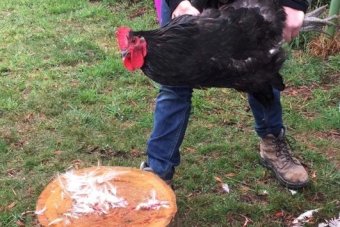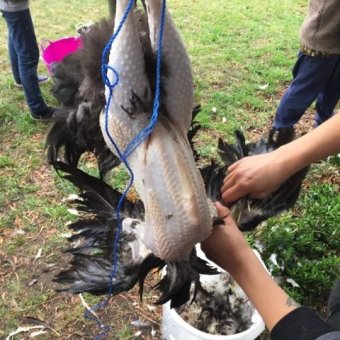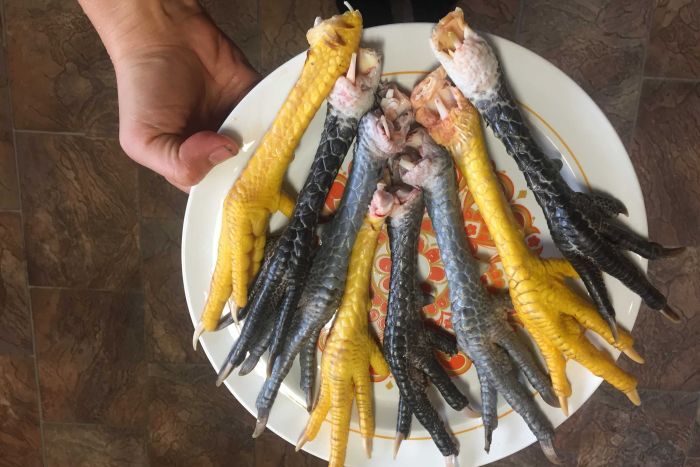Meet the people learning to cull their own animals so they can feed themselves sustainably
Updated
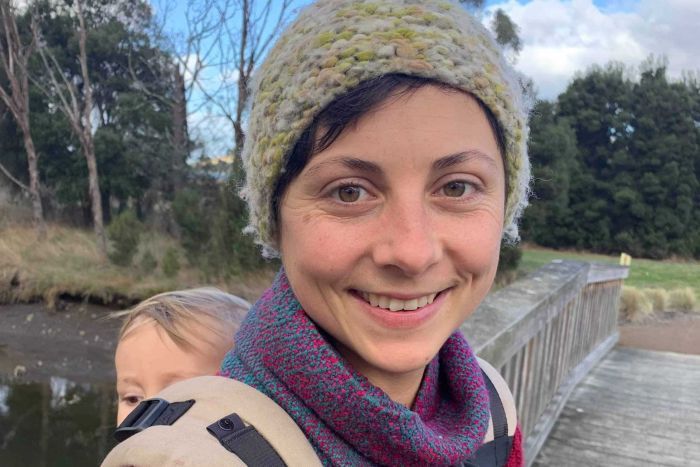 Photo:
Lara Bakewell believes it's important to have the skills to humanely slaughter the animals you want to eat. (Supplied: Lara Bakewell)
Photo:
Lara Bakewell believes it's important to have the skills to humanely slaughter the animals you want to eat. (Supplied: Lara Bakewell)
It might not be everyone's idea of a family activity.
On a crisp autumn Sunday recently, Lara Bakewell and her family took the drive south to Tasmania's Huon Valley to learn to kill roosters.
Warning: this story contains images that some people may find distressing.
"I find it, just for myself, hypocritical if I can eat it, but I can't think about where it came from or how it was treated before I ingested it," she said.
"It was super important for me and for my family to know where that food source comes from and that it is natural and treated with as much respect as possible."
Ms Bakewell is part of an enthusiastic group learning to process and prepare their own meat, fruit and vegetables — a grassroots movement gaining momentum.
Lisa Appelgren and a friend started the social media group as a way to build community and share the skills needed to feed themselves affordably.
"A lot of the workshops and things — bread-making and passata-making — they're really expensive," Ms Appelgren said.
"I saw one that was $350 for the day, and I can't afford that, so I just wanted to start a group where it was accessible for everyone.
"And that's why we made it that every thing has to be free in our group."
They've held workshops on preserving and pickling fruit and vegetables that has been grown or foraged, as well as the recent rooster culling day.
"With the roosters, that started with my neighbour and I, we didn't have a lot of money, and we've got five children between us, neither of us wanted to eat [supermarket] meat and we can't afford the organic supermarket meat, so that was a way to feed our kids in a cheaper way," she said.
"I forage, things like apples and plums and rosehips, when I want meat I put the word out for unwanted roosters and people give me their roosters. We also do a bit of bartering.
"It's a real mix, there are newbies that have never done anything like this, there are people with no money, there are people with a lot of money.
"But there are [also] a lot of people who are doing it so they can feed their kids healthy food."
The 'food paradox' in Australia
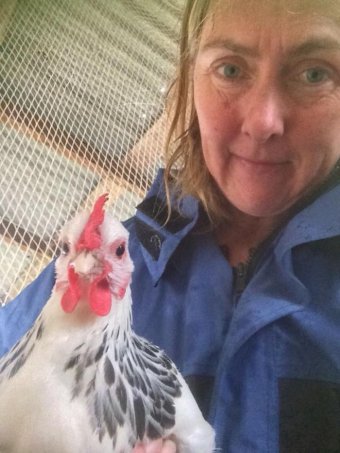 Photo:
Lisa Appelgren says she wanted to start a free group where skills and produce were shared (Supplied: Lisa Appelgren)
Photo:
Lisa Appelgren says she wanted to start a free group where skills and produce were shared (Supplied: Lisa Appelgren)
For a country that produces two and a half times more food than it needs, Australia has a lot of people going hungry, or facing what's called food insecurity.
More than 4 million Australians, or 18 per cent, have experienced food insecurity in the past year, and people in remote or regional areas are more likely to not be able to get affordable healthy food, according to Foodbank.
Tasmania, with its mostly regional, often lower income population is a study in food insecurity, despite its apparent bounty.
"What we see in Tasmania is that many people struggle to put good healthy food on the table every day," Sandy Murray, a dietitian and University of Tasmania lecturer, said.
"Because of where people live, geographically, in Tasmania, and if you don't have a car you might struggle to get to a shop to buy the food and then to get it home.
"More importantly [there are] financial challenges, because Tasmania has a number of unemployed or under employed people.
"Food security is folks being able to put healthy food on the table every day, not just occasionally.
"I use the term the Tasmanian Food Paradox, where we have some of the best fruit and veg production in Australia, and perhaps globally, but unfortunately here in Tasmania we have some of the worst health outcomes.
"And these health outcomes are often, and mostly linked to lifestyle and what we eat, and with poor access to good healthy food it makes it challenging for people who are on a low income or just can't get access to good local healthy food."
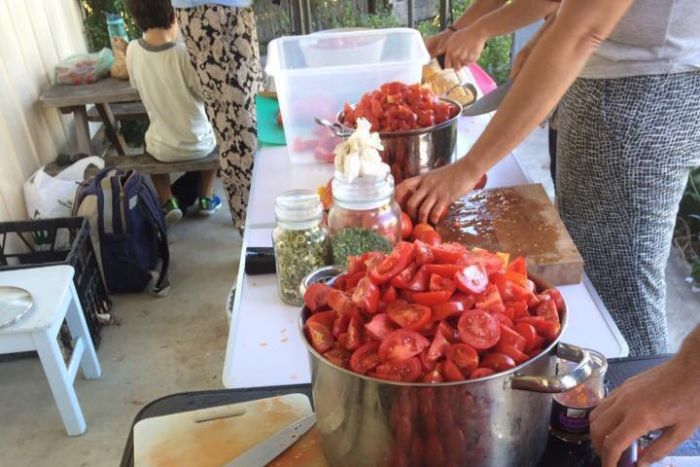 Photo:
A recent "tomato gathering" saw kilos of excess fruit turned into passata to use year-round. (Supplied: Lisa Appelgren)
Photo:
A recent "tomato gathering" saw kilos of excess fruit turned into passata to use year-round. (Supplied: Lisa Appelgren)
Giving back the power
Ms Murray said there are community programs to provide low-cost fruit and vegetables to families, and also to teach people how to grow food.
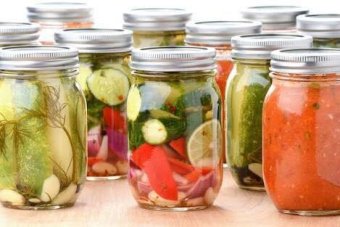 Photo:
The group comes together to learn skills of processing and preserving food. (Supplied: Lisa Appelgren)
Photo:
The group comes together to learn skills of processing and preserving food. (Supplied: Lisa Appelgren)
"A kind of a backyard buddy system where they have a support person helping community members set up veggie plots in their back yards, which is a wonderful way for people to actually realise they can grow vegetables, harvest them and eat them in their own communities," she said.
"In Ravenswood they have a community food forest program at the community house there.
"So we are seeing this real grassroots initiative coming from the community and now they're talking about 'food justice' instead of 'food insecurity'.
"They're giving themselves back their power, so they don't have to rely on emergency food relief, they're growing their own and there's a sense of real sense of self reliance."
That idea of self-reliance is echoed by Ms Bakewell, who said the rooster culling day gave her more confidence to produce her own meat.
"Yes, definitely, and even my kids expressed an interest in raising our own [roosters] and killing them and eating them as well," she said.
"Consumers are really showing they want to know where their food comes from, they want to know how it was treated — more people are becoming aware of the conditions in factory farms and in large-scale enterprises.
"We don't really eat a lot of meat these days, and I try to avoid factory-farmed [meat] as much as possible.
"We just really wanted to know, from the get-go, how it was raised, how it was killed, how it was prepared and being able to do it yourself is a skill that I think is really important."
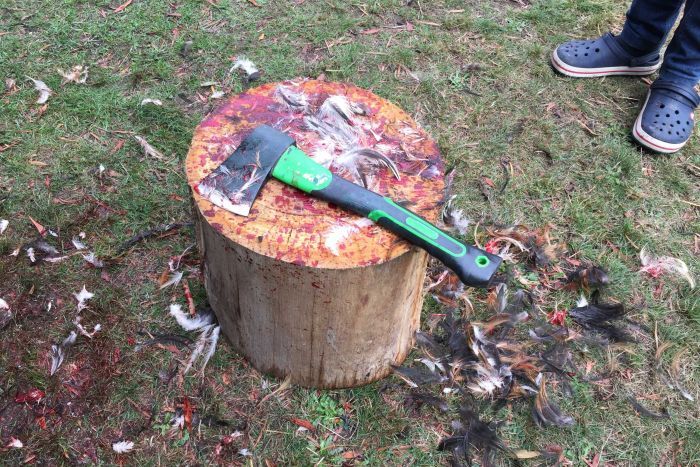 Photo:
Lara Bakewell says it was important for her to know where her food came from. (Supplied Lara Bakewell)
Photo:
Lara Bakewell says it was important for her to know where her food came from. (Supplied Lara Bakewell)
Topics: food-and-cooking, sustainable-living, human-interest, cygnet-7112, hobart-7000, launceston-7250, tas
First posted


